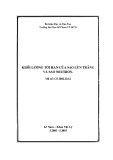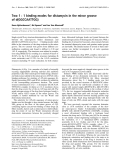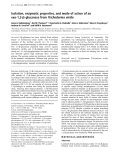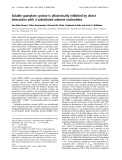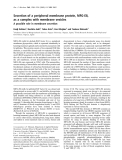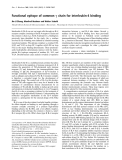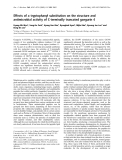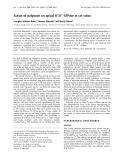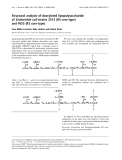
Assignment of molecular properties of a superactive coagulation
factor VIIa variant to individual amino acid changes
Egon Persson
1
and Ole H. Olsen
2
1
Haemostasis Biology and
2
Medicinal Chemistry Research IV, Novo Nordisk A/S, Ma
˚løv, Denmark
The most active factor VIIa (FVIIa) variants identified to
date carry concurrent substitutions at positions 158, 296 and
298 with the intention of generating a thrombin-mimicking
motif, optionally combined with additional replacements
within the protease domain [Persson, E., Kjalke, M. &
Olsen, O. H. (2001) Proc. Natl Acad. Sci. USA 98, 13583–
13588]. Here we have characterized variants of FVIIa
mutated at one or two of these positions to assess the relative
importance of the individual replacements. The E296V and
M298Q mutations gave an increased intrinsic amidolytic
activity (about two- and 3.5-fold, respectively) compared
with wild-type FVIIa. An additive effect was observed upon
their combination, resulting in the amidolytic activity of
E296V/M298Q-FVIIa being close to that of the triple
mutant. The level of amidolytic activity of a variant was
correlated with the rate of inhibition by antithrombin (AT).
Compared with wild-type FVIIa, the Ca
2+
dependence of
the intrinsic amidolytic activity was significantly attenuated
upon introduction of the E296V mutation, but the effect was
most pronounced in the triple mutant. Enhancement of the
proteolytic activity requires substitution of Gln for Met298.
The simultaneous presence of the V158D, E296V and
M298Q mutations gives the highest intrinsic activity and is
essential to achieve a dramatically higher relative increase in
the proteolytic activity than that in the amidolytic activity.
The N-terminal Ile153 is most efficiently buried in V158D/
E296V/M298Q-FVIIa, but is less available for chemical
modification also in the presence of the E296V or M298Q
mutation alone. In summary, E296V and M298Q enhance
the amidolytic activity and facilitate salt bridge formation
between the N-terminus and Asp343, E296V reduces the
Ca
2+
dependence, M298Q is required for increased factor X
(FX) activation, and the simultaneous presence of the
V158D, E296V and M298Q mutations gives the most pro-
found effect on all these parameters.
Keywords: factor VIIa variant; factor X activation; intrinsic
activity; superactivity; zymogenicity.
Coagulation factor VIIa (FVIIa), in contrast to other,
homologous serine proteases, possesses an active confor-
mation that is energetically unfavourable. The consequence
is a far from optimal enzymatic activity of free FVIIa, which
is dramatically enhanced upon binding to the cognate,
membrane-bound cofactor tissue factor (TF) or to its
extracellular, soluble portion (sTF) [1]. In the natural
environment, the zymogenicity of free FVIIa ensures timely
triggering and appropriate location of FVIIa haemostatic
activity upon vascular lesion and concomitant TF exposure.
The three-dimensional structure of the protease domain
of free FVIIa is, apart from certain loop regions, virtually
identical to that of thrombin and other constitutively active
and homologous serine proteases [2,3]. In addition, the
structural differences between free [3–5] and TF-bound
FVIIa [6,7] are subtle; thus the details in molecular
architecture that restrict the activity of free FVIIa remain
elusive. However, the high degree of similarity may be due
to the presence of an active site inhibitor in the structure of
the free FVIIa. The crystal (or solution) structure of
noninhibited FVIIa is presumably needed to reveal the
structural differences between latent(zymogen-like) and
activeFVIIa. However, information possibly pertaining to
the latent conformation of free FVIIa has been obtained
from the crystal structure of zymogen FVII [8]. This
structure suggests that relative bstrand movements and a
hydrogen bond involving Glu296{154} (chymotrypsinogen
numbering is given in curly brackets to facilitate compar-
isons with homologous enzymes) regulate the activity state
of FVIIa.
Recent advances in our understanding of the mechanisms
regulating the activity of FVIIa have pinpointed side chains
that function as zymogenicity determinants in the free
enzyme. Replacements of these amino acid residues have
resulted in FVIIa molecules with improved intrinsic
(TF-independent) catalytic efficiency [9–11]. The relatively
high intrinsic activity of some of these FVIIa variants
suggests that the zymogen-like conformation of free factor
VIIa is dictated by a limited number of key amino acid
residues. We have previously shown that one of these
superactive FVIIa variants, containing the mutations
V158{21}D, E296{154}V and M298{156}Q, exhibits several
properties resembling TF-bound rather than free FVIIa [9].
Apart from increased intrinsic enzymatic activity and
inhibitor susceptibility as compared with wild-type FVIIa,
this mutant has a diminished requirement for calcium ions
and a more deeply buried protease domain N-terminus
Correspondence to E. Persson, Haemostasis Biology, Novo Nordisk
A/S, Novo Nordisk Park, DK-2760 Ma
˚løv, Denmark.
Fax: + 45 44434417, Tel.: + 45 44434351,
E-mail: egpe@novonordisk.com
Abbreviations: FVIIa, coagulation factor VIIa; FX, coagulation factor
X; sTF, soluble tissue factor (residues 1–219); TF, tissue factor;
AT, antithrombin (III).
(Received 20 June 2002, revised 2 October 2002,
accepted 22 October 2002)
Eur. J. Biochem. 269, 5950–5955 (2002) FEBS 2002 doi:10.1046/j.1432-1033.2002.03323.x

(Ile153{16}) indicating salt bridge formation of this residue
with Asp343 {194}. To pinpoint the underlying mutation(s)
responsible for these molecular and functional properties of
the triple mutant, and thereby gain more knowledge about
the zymogenicity determinants of FVIIa, mutants with
substitutions at one or two of positions 158{21}, 296{154}
and 298{156} were expressed and characterized.
MATERIALS AND METHODS
Proteins, chemical reagents and standard methods
Wild-type FVIIa [12] and sTF [13] were prepared according
to published procedures. The concentrations of FVIIa and
sTF were determined by ELISA and spectrophotometry,
respectively, as described [9]. SDS/PAGE was run on
8–25% gradient gels using the PhastSystem (Amersham
Pharmacia) and followed by silver staining to check the
purity of the FVIIa mutants and to verify their conversion
to the activated, two-chain form. Factor X (FX) and factor
Xa were from Enzyme Research Laboratories (South Bend,
IN, USA) and antithrombin (AT) from Hematologic
Technologies (Essex Junction, VT, USA). Unfractionated
heparin was from Leo Pharmaceutical Products (Ballerup,
Denmark), potassium cyanate (KOCN) from Merck and
the chromogenic substrates S-2288 (
D
-Ile-Pro-Arg-p-nitro-
anilide) and S-2765 (benzyloxycarbonyl-
D
-Arg-Gly-Arg-
p-nitroanilide) from Chromogenix (Mo
¨lndal, Sweden).
Mutagenesis and preparation of FVIIa mutants
The FVII expression plasmid pLN174 [14] was used as the
template for site-directed mutagenesis using the Quik-
Change kit (Stratagene, La Jolla, CA, USA). The primer
(only sense primer is given) used to introduce the E296V
mutation, with base substitution in italic and the affected
codon underlined, was GCC ACG GCC CTG GTGCTC
ATG GTC CTC. The primers used to introduce the V158D,
E296V/M298Q and M298Q mutations have been described
[9]. Plasmid preparation, baby hamster kidney cell trans-
fection and selection, and the expression, purification and
autoactivation of FVII mutants were carried out as
described [9,15]. The presence of none but the desired
mutation(s) was verified by sequencing the portion of the
cDNA encoding residues 80–406, encompassing the
second epidermal growth factor-like and serine protease
domains, on a MegaBACE 1000 (Amersham Pharmacia
Biotech).
Activity and inhibition assays
The enzymatic activity and inhibition rates of the FVIIa
variants were measured as described [9] using an assay
buffer containing 50 m
M
Hepes, 0.1
M
NaCl, 5 m
M
CaCl
2
and 1 mgÆmL
)1
bovine serum albumin (pH 7.4). Briefly, the
amidolytic activity was measured by mixing 180 lL wild-
type or mutant FVIIa alone (final concentration 100 n
M
)or
180 lL FVIIa together with sTF (final concentrations
10 n
M
FVIIa and 50 n
M
sTF) with 20 lL10m
M
S-2288 at
25 C. The measurement with free FVIIa was also per-
formed in an assay buffer where CaCl
2
was replaced by
EDTA. The ability of the FVIIa variants to activate FX (the
proteolytic activity) was studied by incubating 10 n
M
(M298Q-, V158D/M298Q-, E296V/M298Q- and V158D/
E296V/M298Q-FVIIa) or 50 n
M
(wild-type, V158D-,
E296V-, and V158D/E296V-FVIIa) FVIIa variant alone
or 5 n
M
FVIIa variant plus 100 n
M
sTF with various
concentrations of FX (0.1–4.8 l
M
)for20minatambient
temperature (22 ± 1 C). Buffer containing S-2765 was
then added to give a chromogenic substrate concentration
of 0.5 m
M
, whereafter the factor Xa-catalyzed hydrolysis
was measured for 2 min. The inherent activity of the FX
substrateandoftheFVIIa/sTFmixtureweresubtracted
and the net amount of factor Xa generated was derived
from a standard curve. The kinetic parameters of FX
activation were calculated using
GRAFIT
4.06 (Erithacus
Software, Ltd). The rates of inhibition by AT/heparin and
potassium cyanate were studied according to published
methods [9] by incubation of the FVIIa variants (100 n
M
with AT and 1 l
M
with cyanate) with the inhibitor for 15
and 60 min, respectively, followed by measurements of the
residual amidolytic activity. Bovine serum albumin was
omitted from the buffer during the incubation with cyanate.
RESULTS
Enzymatic activity of FVIIa variants
Two forms of enzymatic activity are analyzed. The amido-
lytic activity is measured to assess the functional status of
the active site, whereas the proteolytic activity reflects both
this and exosite alterations resulting in further increased
macromolecular substrate turnover. In the absence of TF,
V158D/E296V/M298Q-FVIIa has seven- to eight-fold
higher intrinsic amidolytic activity compared with wild-type
FVIIa as measured by the rate of hydrolysis of the
chromogenic substrate S-2288 [9]. When the mutations
were introduced individually into FVIIa, V158D had no
significant effect on the amidolytic activity, whereas E296V
and M298Q yielded approximately two- and 3.5-fold
enhancement, respectively (Table 1). The result with
M298Q-FVIIa agrees with earlier reports [9,10]. The double
mutant E296V/M298Q-FVIIa had an amidolytic activity
six times higher than that of wild-type FVIIa and close to
that of V158D/E296V/M298Q-FVIIa. In addition, V158D/
E296V-FVIIa had significantly lower amidolytic than
E296V-FVIIa and V158D/M298Q-FVIIa had similar or
slightly lower activity than M298Q-FVIIa. This shows that
the simultaneous presence of the E296V and M298Q
mutations suffices to achieve an amidolytic activity similar
Table 1. Enzymatic activity of free FVIIa variants. All values are
means ± SD (n¼3). The amidolytic activity is given as the ratio
between the activity of mutant and wild-type FVIIa.
FVIIa variant
Amidolytic activity
(mutant/wt)
FX activation
(k
cat
,·10
)3
s
)1
)
Wild-type 0.088 ± 0.006
V158D 1.0 ± 0.1 0.069 ± 0.008
E296V 2.1 ± 0.3 0.083 ± 0.010
M298Q 3.4 ± 0.4 0.62 ± 0.04
V158D/E296V 0.6 ± 0.1 0.081 ± 0.009
V158D/M298Q 3.0 ± 0.5 0.60 ± 0.05
E296V/M298Q 6.0 ± 0.5 0.47 ± 0.07
V158D/E296V/M298Q 7.6 ± 0.5 2.2 ± 0.3
FEBS 2002 Dissection of a superactive FVIIa variant (Eur. J. Biochem. 269) 5951

to that of the triple mutant and that the substitution of Asp
for Val at position 158 has an insignificant or negative
impact on the amidolytic activity. In complex with sTF,
none of the investigated mutants had an amidolytic activity
significantly different from that of wild-type FVIIa (not
shown).
The amidolytic activity of free FVIIa has been shown to
be at least about 10 times higher in the presence of 5 m
M
Ca
2+
than in the absence of the metal ion [16,17]. As
expected, in the absence of Ca
2+
wild-type FVIIa exhibited
an amidolytic activity corresponding to about one tenth of
its activity in the presence of 5 m
M
Ca
2+
. This was also the
case for V158D-FVIIa, M298Q-FVIIa and V158D/M298Q-
FVIIa. In contrast, all FVIIa variants containing the E296V
mutation retained a larger fraction of their activity when
Ca
2+
was omitted from the assay buffer; E296V-FVIIa
(retained 24% of the activity), V158D/E296V-FVIIa (29%),
E296V/M298Q-FVIIa (39%) and, in particular, V158D/
E296V/M298Q-FVIIa (64%). This shows that the substitu-
tion of Val for Glu296{154}, which contacts the acidic Ca
2+
binding loop in the protease domain, attenuates the Ca
2+
dependence of FVIIa and confirms that this replacement is
responsible for the diminished Ca
2+
requirement observed
for V158D/E296V/M298Q-FVIIa [9]. The additional sub-
stitution of Gln for Met298{156}, especially in combination
with the replacement of Val158{21} by Asp, further
attenuates the Ca
2+
dependence.
We have previously shown that, in the absence of TF, the
k
cat
values for FX activation by M298Q-FVIIa and V158D/
E296V/M298Q-FVIIa were increased 5.5- and 28-fold
compared with that of wild-type FVIIa, respectively [9]. In
agreement with these results, the new batches of the two
variants displayed seven- and 25-fold higher values, respect-
ively (Table 1). E296V/M298Q-FVIIa and V158D/M298Q-
FVIIa activated FX five to seven times more rapidly than
did wild-type FVIIa, rates similar to that seen with M298Q-
FVIIa. This indicates that the introduction of the V158D or
E296V mutation on the M298Q-FVIIa background does
not contribute to an increased proteolytic activity. Indeed,
an increased rate of FX activation was only observed for the
FVIIa variants containing the M298Q mutation, and
V158D-FVIIa, E296V-FVIIa and V158D/E296V-FVIIa
exhibited a rate of catalysis of FX activation similar to or
slightly below that of wild-type FVIIa. It is noteworthy that
FX activation occurs much faster when catalyzed by
V158D/E296V/M298Q-FVIIa than when catalyzed by
V158D/E296V-FVIIa, V158D/M298Q-FVIIa or E296V/
M298Q-FVIIa. This suggests that the triad composed of
residues 158{21}, 296{154} and 298{156} works as a unit
regulating macromolecular substrate processing by free
FVIIa. All FVIIa variants (including the wild-type enzyme)
gave K
m
values for FX between 2.2 and 2.8 l
M
indicating
that the mutations did not affect substrate affinity to a
detectable extent (data not shown). When bound to sTF,
none of the studied FVIIa variants exhibited an increased
ability to activate FX as compared with wild-type FVIIa
(not shown).
Inhibition of FVIIa variants by antithrombin
and potassium cyanate
The susceptibility of the FVIIa variants to inhibition by
two mechanistically different agents, antithrombin (active
site-directed) and potassium cyanate (N-terminal carbamy-
lation), was investigated. The rate of inhibition by anti-
thrombin reflects the reactivity of the active site and has
previously been found to nicely correlate to the level of
amidolytic activity of FVIIa variants [9]. The results herein
show that the new variants also obey this rule, with a strong
relationship between amidolytic activity enhancement and
increased inhibition rate (Table 2). The inhibition resulting
from potassium cyanate-mediated, N-terminal carbamyla-
tion reflects the degree of exposure of the protease domain
N-terminus. When compared with that of wild-type FVIIa,
the susceptibility to carbamylation was found to be
strikingly reduced for V158D/E296V/M298Q-FVIIa (and
reduced to some extent also for M298Q-FVIIa) indicative of
a more buried N-terminal amino group [9]. A majority
of the present FVIIa variants exhibits an intermediate level
of protection from carbamylation (Table 2). E296V-FVIIa
retains about half of its activity after incubation with
potassium cyanate, which is slightly more than wild-type
FVIIa. V158D/E296V-FVIIa, V158D/M298Q-FVIIa and
E296V/M298Q-FVIIa all retain about 60% of their activity,
which is similar to the residual activity of M298Q-FVIIa but
considerably less than that of V158D/E296V/M298Q-
FVIIa. This indicates that no single mutation is particularly
efficient in terms of promoting the insertion of the
N-terminus and, importantly, demonstrates that all three
mutations are needed for stable burial of the N-terminus,
most likely through salt bridge formation with
Asp343{194}).
DISCUSSION
V158D/E296V/M298Q-FVIIa has been found to possess
unique properties that differ dramatically from those of
wild-type FVIIa (Fig. 1). This includes an increased intrinsic
activity, a reduced activity dependence on Ca
2+
and a
buried protease domain N-terminus [9]. The characteriza-
tion of FVIIa variants containing one or two of the
mutations at positions 158{21}, 296{154} and 298{156} has
enabled the identification of the amino acid changes mainly
responsible for the unique profile of the triple mutant.
M298Q is the single mutation that enhances the amidolytic
activity to the largest extent. The E296V mutation, on the
other hand, appears to be responsible for the decreased
calcium ion dependence of the amidolytic activity, with the
other two mutations functioning as modulators of this
Table 2. Inhibitor susceptibility of free FVIIa variants. The residual
activity (%) after incubation with the inhibitor for 15 min (anti-
thrombin) and 60 min (KNCO) is given (means ± SD, n¼3).
FVIIa variant
Inhibitor
Antithrombin KNCO
Wild-type 71 ± 4 38 ± 4
V158D 75 ± 6 44 ± 7
E296V 67 ± 6 48 ± 6
M298Q 48 ± 4 66 ± 5
V158D/E296V 74 ± 8 60 ± 6
V158D/M298Q 41 ± 5 58 ± 8
E296V/M298Q 24 ± 4 64 ± 3
V158D/E296V/M298Q 19 ± 2 87 ± 4
5952 E. Persson and O. H. Olsen (Eur. J. Biochem. 269)FEBS 2002


